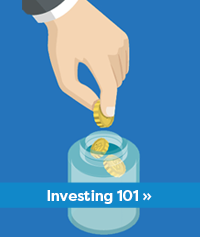Exploring Low-Risk Investment Options

Investing can seem intimidating. After all, there’s a misconception that investments are inherently risky and complicated. But having confidence in your finances and understanding your options can make investing easy. Discover how your money can make you money by learning about CUA’s low-risk investment options below.
You might be wondering what we mean by ‘low-risk.’ All investments by nature carry some risk, but with low-risk investments you can feel secure in knowing there is less at stake. Generally, by taking on lower risk you have lower potential for return, but this can also protect you from significant loss. Many of CUA’s low-risk investment options offer a guaranteed return on investment, which means that you’re not at risk of losing any of the money you invest and will have that amount (at minimum) returned to you at the end of the term. Sound too good to be true? Keep reading to learn more.
Index-Linked Term Deposits
The first safe investment option we’ll explore are Index-Linked Term Deposits (ILTD); These are fixed term deposits that pay a return based on the performance of the S&P/TSX 60 Index, which tracks the 60 top companies in leading industries in Canada. A fixed-term deposit like that of an ILTD means that you are investing for a specific period of time. At CUA, for example, ILTD terms can either be three years or five years. The amount that you initially invested is guaranteed when the term of your deposit ends, regardless of what happens to the stock market, giving you peace of mind and the potential for gains, which is why ILTDs are quite popular with low-risk investors. You can learn more about how these deposits work in this CUAdvice article.
Guaranteed Investment Certificates
Guaranteed Investment Certificates (GICs) are another form of investment that offer a guaranteed rate of return over a set period of time, making them particularly popular during times of high interest rates. GICs provide secure, worry-free investing for short- or long-term funds; terms at CUA range from 30 days to five years. You have a few different options when it’s time to choose your GIC, starting with the redeemable option.
A redeemable GIC means that you don’t have to wait until the end of the term to take out your money; you can withdraw at any time without penalty. However, if you do choose to redeem early, you might receive a lower interest rate and lower earnings. For individuals interested in a redeemable GIC with CUA, members can get up to 3% return on a one-year redeemable term until March 31, 2023.
A non-redeemable GIC, on the other hand, locks your money in for a fixed period of time. CUA offers two forms of non-redeemable GICs: short-term and long-term. The former is ideal for individuals who are looking for term lengths of less than a year. At CUA, a short-term non-redeemable GIC ranges from 30 to 364 days, with a minimum deposit of $5,000. However, when you invest for a longer term, this minimum deposit decreases. Such is the case with long-term non-redeemable GICs, with term lengths at CUA ranging from one to five years.
Under a long-term non-redeemable GIC, you have two more options for your investment type: registered or non-registered. ‘Registered’ refers to investments that are registered with the government and are not taxed until withdrawn, meaning you have a higher potential to earn money on your investment. Examples of government-registered accounts include TFSAs, RRSPs and RESPs, which we’ll take a look at in more depth shortly. The minimum deposit for registered investments at CUA is $500. Alternatively, non-registered investments don’t have the same tax benefits (which means you need to claim your earnings as investment income) but they also have fewer limits and regulations. This investment type has a minimum deposit of $1,000.
Regardless of which GIC options you’re most interested in, rest assured that these are secure investment options designed to help you succeed. You can find a complete overview of CUA’s GIC options here.
Tax-Free Savings Accounts
A Tax-Free Savings Account (TFSA), much like the name implies, is an investment option that lets you earn tax-free investment income and is a registered product with the federal government. With TFSAs, you’ll have an annual contribution limit (at CUA, this is $6,000), but within this limit you’ll enjoy tax-free savings on withdrawals made or income earned – no matter how much profit your investments yield. These accounts are great for saving up for a short-term goal, such as buying a car or going on vacation. As mentioned above, TFSAs are also wonderful vessels for holding and growing your investments, including GICs, to avoid being taxed on any interest earned. These accounts are available for anyone over the age of 18 with a valid Social Insurance Number, and can be opened through a financial institution, insurance company, or by contacting a member of our CUA team!
Registered Savings Plans
Next, we’ll take a look at Registered Retirement Savings Plans (RRSPs) and Registered Education Savings Plans (RESPs), which you’ll recall are types of low-risk and government-registered investment options designed to help you save for retirement and your child’s future university or college education. A big benefit of these plans is that you don’t have to pay tax on the income earned on your investments until you withdraw the funds. You can easily set up these accounts through your financial institution. At CUA, you have a few different product types available for RRSPs, including ILTDs, variable RRSPs, fixed term RRSPs and convenient monthly RRSP deposits. With RESPs there are three plan-types: a family plan for families with more than one child, an individual plan which is ideal if you are not related to the child you are saving for, and a group plan, which is for one child only (who doesn’t need to be related to you). If you’re considering either an RRSP or RESP, remember that the earlier you open your plan, the longer you have to accumulate retirement and education savings.
High-Interest Savings Accounts
Finally, we have high-interest savings accounts (HISAs) which, when compared to regular savings accounts, are designed to encourage saving by offering a higher interest rate. This rate is applied to your account balance and is calculated daily but paid out monthly. While interest rates are always subject to change based on market conditions, CUA currently offers a 1.25% interest rate on your savings; plus, CUA will deposit up to $50 into your account to help you start to build this balance.
While you don’t have to worry about monthly account fees with HISAs, there may be fees associated with certain transactions such as withdrawals. It’s important to check with your financial institution to learn which eligibility criteria is involved when setting up your HISA. For example, at CUA, you’ll be required to set up an Automated Funds Transfer (AFT) of a minimum $50 per month deposit into your account.
For individuals looking for a safe investment option, these accounts are low-effort and straightforward, making HISAs a savvy option for anyone looking to grow their savings.
Start your low-risk investments
We hope this article gave you some ideas for low-risk investment options to help you get started. While this list doesn’t cover every investment option, it should give you a starting point for building your wealth. If you have a question about any of the above plans or accounts, or if you’d like to learn more about the different low-risk investment options available, reach out to a member of our team via email or call 902.492.6500. We’re happy to discuss a tailor-made investment plan that works best for you and your family.
Published Feb. 8, 2023






